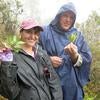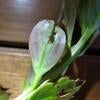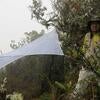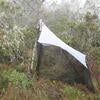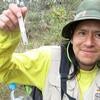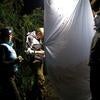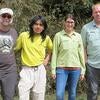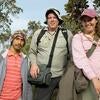After-Congress Collecting in the Kosñipata Valley
John Heraty, University of California, Riverside
Following the 8th Congress of the International Society of Hymenopterists in Cusco, Peru, we spent five days at the Wayqecha Biological Station (13°10' 38"S, 71°36' 16"W). The station is nestled into the hillside at about 2900m at the upper reaches of the Kosñipata (or Cosñipata) River. The elevation of the station property ranges from 2200 to 3700m, and according to Wikipedia: "includes several Andean ecosystems, such as montane forests, elfin forests, montane scrub and high-Andean grassland (puna)". A more general characterization would be high-elevation cloudforest. The steep terrain around the station and close vicinity of Manu National Park make this an ideal collecting habitat. Of course, we were there for one primary reason - to collect the host of a new species of Orasema (Eucharitidae). On an earlier expedition in 2011 to the same station, we were able to collect these veritable monster Orasema (~4 mm) with patterned wings, and associate them with the host plant Myrsine (Myrsinaceae), which is a small tree-like shrub. On the previous trip in December, we noted that the leaves of virtually every Myrsine plant from 2400m to 3400m were covered with egg punctures. Females deposit single eggs into egg punctures formed in the lower leaf surface using their enlarged ovipositors, and oviposit in irregular parallel rows along the leaf. On that first trip, we were able to find lots of adults, egg punctures and planidia (active first-instar larvae), but no ant host (actually, virtually no ants at all). Of real interest as well was the finding of patches of extrafloral nectaries at the bases of the leaves, which were similar to the EFN found on desert willow, a plant associated with Orasema simulatrix in North America (cf. Carey et al. JHR 27: 47–65). Also, the Myrsinaceae literature mentions the potential use of extrafloral nectaries by the plant to divert the ants’ attention away from the flowers, preventing their interference with beneficial pollinators (citation?). Sounds great, but on that first Peru trip we did not find any potential hosts (Pheidole), or in fact, any ants at all on the Myrsine. We tried tracking the ants with peanut butter baits both during the day and at night, but no luck.
Fast forward to July 2014 after the congress. Our 'eucharitid team' consisted of Judith Herreid, Jason Mottern and myself, all from UCR, and Misael Garate (undergrad from Universidad Nacional de San Antonio Abad del Cusco). Moral support was provided by the Brits (Natalie Day-Sky, Gavin Broad and Andy Polaszek), the Canadians (Barb Sharanowski, Miles Zhang, Patrick Pikarski), and the Estonian (Marko Prous). We crossed the high Andes and the 4500m pass into the Kosñipata Valley with ease (no snow except in the distant mountain peaks). After a quick lunch with the hym crew headed to the Villa Carmen Biological Station (300m) and unpacking, we hit the Perdiz trail for some afternoon collecting. It took all of about 15 minutes to collect the first Orasema, removing the stress over whether we could collect the same wasps in the Andean winter. Egg punctures were everywhere again. Now, back to the ants. Peanut-butter baits worked well on the ground and we found our first slow Pheidole coming to the night baits. We then tried some of the ant 'tricks' learned from the ant-course involving tracking trails with ground-up Keebler pecan sandie cookies and some UV-florescent powder. Eventually we got the ants to 'take the bait' and started narrowing in on the colony entrances, but the colonies were nestled in the dense ground thatch. We skulked out a few sites and tried gently clearing the thatch to locate nest entrance, but this just made the ants disappear. Almost by accident, we ripped up some thatch at the base of a Myrsine plant, and lo and behold, not just Pheidole brood, but also the first eucharitid pupa! A bit more ripping and we had two ant colonies, plenty of brood and all of the eucharitid immature stages. Not bad for the first day of the trip. Sweet success - almost.
Now on to the ant-plant association, and the real reason why I am writing this article. We need some help and advice. We now have the ant host. We know where the Orasema are laying their eggs (in punctures over the lower leaf surface). Females oviposit only into two plants, likely two species of Myrsine. The common Myrsine had numerous extrafloral nectaries (EFN) at the base of each leaf, whereas the other species had only two large fluid-filled EFN at the base of the leaf. Living planidia that had emerged were found at the base of the leaf near the EFN, but never toward the apex of the leaf and never far down on the leaf stalk or plant stem. The planidia are not very active and making their way to the ground is not a likely option. Our problem is that we never found a single ant on the plants. We peanut butter baited the shrub canopy and swept the Myrsine, but no ants. I think we got the odd Camponotus, but never Pheidole. Pheidole were common on the ground peanut butter baits, but non-existent above. The Pheidole were most active during the day, and less so at night, which is likely an adaptation to the cold nighttime temperatures, but still, never on the plants going after the EFN. Seasonality would not seem to be a factor, since the Orasema and the presence and activity of the planidia was the same in December (summer) and July (winter). What would make the Pheidole 'choose' to enter the Myrsine canopy and interact with the EFN and the associated waiting planidia? If anyone has any ideas to pass along, or is just looking for a great research question to answer in the mountains of Peru, we would be glad to hear from you!
This research was sponsored in part by NSF DEB 1257733 grant to JMH.


